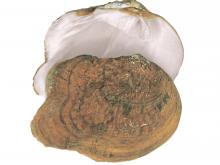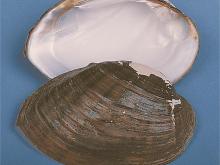Aquatic Invertebrates
Media

Species Types
Scientific Name
Quadrula quadrula
Description
The mapleleaf spawns in the summer, using catfish as a host.
Media

Species Types
Scientific Name
Quadrula metanevra
Description
Finding the monkey’s face in this mussel's shell is left up to the imagination.
Media

Species Types
Scientific Name
Actinonaias ligamentina
Description
One of the most widespread and numerous mussels in southern Missouri.
Media

Species Types
Scientific Name
Quadrula pustulosa
Description
While the pimpleback is usually bumpy, some individuals are perfectly smooth.
Media

Species Types
Scientific Name
Tritogonia verrucosa
Description
Shaped like a checkered gunstock, with its unique, turned-down edge, pistolgrips are easy to identify.
Media

Species Types
Scientific Name
Ligumia subrostrata
Description
This widespread species is one of the few Missouri mussels successful in shallow ponds and lakes.
Media

Species Types
Scientific Name
Pleurobema sintoxia
Description
Round pigtoes are more rounded than Wabash pigtoes. Usually, the nacre (the shell lining) is white, but in rare individuals it is bright pink.
Media

Species Types
Scientific Name
Leptodea leptodon
Description
Rarely seen, this endangered freshwater mussel has a thin and delicate shell that is strikingly beautiful inside.
Media

Species Types
Scientific Name
Epioblasma triquetra
Description
The snuffbox has been classified as endangered in Missouri and is a candidate for federal endangered status. Perhaps it should also be a candidate for a new common name, since the popularity of snuff-taking is long past.
Media

Species Types
Scientific Name
Elliptio dilatata
Description
Nacre color varies from purple to pink to white. In smaller rivers, the shell is much thinner.
See Also
About Aquatic Invertebrates in Missouri
Missouri's streams, lakes, and other aquatic habitats hold thousands of kinds of invertebrates — worms, freshwater mussels, snails, crayfish, insects, and other animals without backbones. These creatures are vital links in the aquatic food chain, and their presence and numbers tell us a lot about water quality.





















